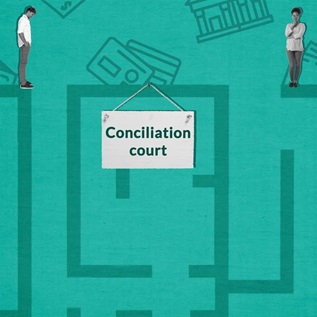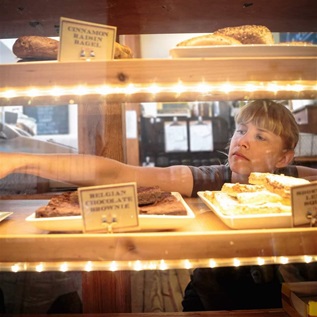Unbanked By Choice
A Look at How Low-Income Los Angeles Households Manage the Money They Earn
QUICK SUMMARY
This study compares banked and unbanked families across several categories including financial behavior, economic status and perceptions of the financial service industry
Executive Summary
American families without a bank account live in a dangerous financial world.1 Lacking access to government-insured savings or opportunities to build credit, they not only incur risks of theft, fraud and loss, but by using alternative financial service (AFS) providers such as check cashers or payday lenders, they also become prey to expensive predatory products and services that make it harder for them to achieve financial security. Prior research by the Pew Health Group (PHG) on California families confirms the widely shared view that having a bank account generally provides access to basic financial services at a lower cost than using AFS.2
To reduce these risks and costs, PHG's Financial Security Portfolio has helped unbanked households open a safe and affordable bank account as the first step in joining the financial mainstream. The PHG Safe Banking Opportunities Project provided research and technical assistance to help more than 50 cities and localities kick off “Bank On” programs that bring together banks, local government and community groups to promote responsible bank account ownership. More recently, we investigated the products and services that banks might provide to attract and serve more unbanked individuals.3
In 2009, we began an in-depth study of the financial behaviors of similarly situated unbanked and banked low-income families to inform policy solutions that would bring more Americans into the financial mainstream. This is the first report from a multi-phase survey of 1,000 banked and 1,000 unbanked households in greater Los Angeles, randomly selected from eight low-income study areas for in-person interviews at several intervals over the course of a year (July 2009 to July 2010). Our findings from the first wave, or phase, of this study suggest several policy directions for further investigation to help unbanked families shift to the safer world of the banked. The data shows different patterns of financial behavior between the Banked and the Unbanked in our study. Moreover, it reveals that the Banked and Unbanked further segment into distinct sub-groups based on their usage of financial services and providers: a banked only group, a cross¬over group that has bank accounts but also uses AFS, an unbanked AFS-only group, and an unbanked cash economy group that uses cash only.
We found some demographic differences between the two groups. The banked respondents in our study are older (40 years) on average than their unbanked counterparts (34.5 years). Both types of respondents are likely to be foreign born (65% for the Banked and 69% for the Unbanked), but each has resided in the United States for many years (21 years on average for the Banked, 14 for the Unbanked). Members of both groups tend to be employed in similar non¬technical professions and have similar unemployment rates (12–13%), but the Banked earn higher wages and salaries (an average of $29,400 annually compared to an average of $17,300 for the Unbanked). With average family sizes of 4.4 and 4.7 persons, respectively, this puts the Banked just above the federal poverty line, and the Unbanked below it. Close to two¬thirds of the Banked (60%) have completed high school, compared to less than half (48%) of the Unbanked (Appendix A).
Summary of Findings
- Having a bank account correlates with saving. All the neighborhoods surveyed are low income. Still, more than twice as many Banked (24%) as Unbanked (11%) report they are earning enough to pay their bills and save for the future. The Banked are more likely to save no matter what form their income takes—direct deposit, check or cash. About half of all surveyed, Banked or Unbanked, are making enough to pay bills but not to save.
- How workers are paid strongly influences banking status. Direct deposit requires a bank account, but payment by check also strongly correlates with being banked. The Unbanked are twice as likely as the Banked to be paid in cash on their primary job.
- The low-income Banked maintain long-term banking relationships. More than two-thirds have been banked five years or more, overwhelmingly with a single institution. Forty percent have been banked more than 10 years. Being charged fees without explanation is the major reason cited by the Banked that would cause them to leave their current bank.
- About one-third of the Banked also use AFS. Sixty-three percent of the banked population uses banking institutions exclusively, while the rest turn to check cashers, supermarkets, liquor stores and other AFS providers in addition to banks. Of these cross¬over, or “underbanked,” users, 78% use AFS services at least once a month.
- Most Unbanked have never had a bank account. Nearly two-thirds (63%) of unbanked respondents in this study have never had a bank account. Almost one-quarter of the Unbanked (22%) previously had an account, but later opted to close it and remain unbanked. Some Unbanked (9%) previously had an account, but say they cannot now qualify for one.4 Three percent of those unbanked in the United States had bank accounts in another country.
- Many of the Unbanked conduct their financial transactions exclusively in cash. Almost one-third (29%) of the surveyed Unbanked exist in the cash economy. As discussed below, we conservatively estimate there are at least a million unbanked persons in the Los Angeles Metropolitan Statistical Area (MSA), making the cash economy segment some 300,000 strong. The other two-thirds of the Unbanked rely on AFS providers for financial transactions.
- Members of the cash economy segment “save” by remitting. Even though the Banked earn more on average than the Unbanked, those in the cash economy group send as much or more money to their families abroad each month than the Banked, while those in the AFS-only group remit the least on average.
- All respondents tend to like and trust the financial provider they have. The Banked are not more satisfied than the Unbanked. Those in the cash economy segment trust banks more than AFS providers, though they use neither. Most of these respondents, particularly Latinos, do not place high trust in credit unions.
Through research and advocacy, PHG's Financial Security Portfolio helps American families gain access to safe and affordable financial products and services that empower them to manage their money, pay their bills and develop a credit rating. Our latest and ongoing effort, a multiphase survey of 1,000 banked and 1,000 unbanked households in greater Los Angeles, examines the financial behavior of these two groups at a level of detail not previously attained.
The objectives of this study are:
- To identify and measure the financial service needs, perceptions and behaviors of low- and moderate-income households in specific neighborhoods of Los Angeles. This new data will fill a gap in knowledge about the potential of this population to actively utilize bank accounts and financial products and services. Our findings in this study to date demonstrate that market opportunities do exist, but that there are significant barriers to market growth. Such information can help banks and credit unions develop effective products and services to serve the unbanked and “underbanked” communities.
- To inform and evaluate the efficacy of publicly-led programs to “bank the unbanked,” especially Los Angeles' Bank On programs, which aim to connect qualified unbanked households to specific banking opportunities. Half of the households interviewed in the study are in communities that have been targeted by a “Bank On” campaign, and half are in socioeconomically similar communities that have not been targeted. In this study's final wave, now in the field, survey takers will assess the impact of these programs.
- To provide a basis for policy solutions on a local, state or national scale. Just as this data can help financial institutions provide for traditionally underserved sectors of the community, it can also help policy makers identify legislative or regulatory changes that support safer and more accessible banking products and services. Such changes could open regulated financial institutions to more Americans, providing them safer and more affordable contexts for building savings, credit and wealth. The survey reveals the need for policy intervention and suggests the benefits that proactive initiatives could confer not only for these populations but for society at large.
Read Full Section: Introduction (PDF)
WHO ARE THE UNBANKED?
- Most of the Unbanked have never had a bank account. Almost two-thirds of unbanked individuals in our survey (63%) have never had a bank account. Thus, they constitute an untapped market for banks. More than one-fifth (22%) of the Unbanked who have had accounts have voluntarily left the mainstream banking system, indicating a high level of customer dissatisfaction. Some of the Unbanked (9%) were expelled from their banks and are now unable to get an account. Only 3% of those unbanked in the United States were banked in another country.
- About two-thirds of the Unbanked use AFS exclusively. The most popular AFS service for this group is bill payment (74%). A smaller, but substantial group (40%) uses check-cashing services. Other common transactions at Los Angeles' AFS providers by the Unbanked include purchasing prepaid calling cards (56%) and money orders (51%).
- Nearly one-third of the Unbanked use cash only. Fully 29% of the surveyed Unbanked live and transact without the assistance of a bank or an AFS provider, making the cash economy segment in Los Angeles' neighborhoods even larger than previous national, state or regional estimates.8 Given the size and demographics of the overall Los Angeles market,9 this suggests that hundreds of thousands of Angelenos live “off the grid” of the mainstream economy.
- The cash economy remits more than any other sub-segment, despite having the lowest incomes. Most unbanked households live below the federal poverty line, with a median annual income between $10,000 and $14,999 for a typical family of five. Unbanked households purchase less housing and amenities than their banked counterparts, but the cash economy segment sends similar or greater amounts of money to their families in other countries than the banked segment. Remittance services to send money overseas continue to be highly used in Los Angeles by both banked (29%) and unbanked (33%) residents. Average monthly remittance amounts range from $189 (AFS only) to $238 (cash economy) per transfer. Members of the cash-only segment make the highest average monthly transfer, sending nearly $50 per month more abroad than their unbanked counterparts who use AFS.
WHO ARE THE BANKED?
- Banked families are more financially secure. While all these respondents are low income, banking correlates with a somewhat increased income. The Banked have a median annual income range between $15,000 and $24,999, while the Unbanked have a median annual income range between $10,000 and $14,999. The average estimated monthly expenditures for Banked households is $1,712, whereas for Unbanked households it is $1,329, for families averaging 4.4 and 4.7 persons, respectively.
- More of the Banked save than the Unbanked. More than twice as many banked (24%) as unbanked (11%) respondents report they are earning enough to pay their bills and save for the future. About half of all surveyed, Banked or Unbanked, say they are making enough to pay bills, but not to save. The Unbanked say they “cannot make enough money to pay their bills” at a higher rate (38%) than the Banked (27%). Among the Banked, nearly all (91%) safeguard at least some of their cash savings in a bank. Nearly half (47%) keep all of their savings in a bank. The survey did not ask where the Unbanked keep their savings.
- The Banked are loyal bank customers who consume a variety of bank services. More than 80% of the Banked patronize a single financial institution. Their banking relationships are long term: 40% have been banked more than 10 years, 69% have been banked for five years or more and 88% have been banked more than one year. They regularly use an average of five products or services, including ATMs, debit cards, checking accounts, check-cashing services (at either a bank or AFS provider) and savings accounts. Roughly one-third (34%) of bank customers in the study's low¬income markets use credit cards, less than half the national average (73%).10 Those in the crossover sub-segment also are apt to use money order and remittance services.
- Many of the Banked also use AFS regularly. Over one-third (37%) of the Banked willingly and regularly use AFS to supplement banking services. Our findings suggest that this crossover segment is substantially larger in low-income Los Angeles neighborhoods than prior national, state or regional estimates indicate.11 Most of the crossover segment (78%) use AFS at least once a month, most often (15%) for cashing checks.
- Even if paid in cash, banked persons are more likely to save. If paid in cash, 88% of the Unbanked will spend with no intent to save. Among banked individuals paid in cash, however, 41% will deposit some or all of the wages into a bank.
Read Full Section: Key Findings (PDF)
The Opportunity for Banks and Credit Unions
The size and density of the underserved Los Angeles community revealed by this study offers financial institutions an opportunity to secure relatively substantial cash deposits in addition to greater fees for transactional services. At least in Los Angeles, the data suggest there are thousands more unbanked households than prior surveys indicate. The FDIC's 2009 national survey of the nation's unbanked population estimated that they represented 7.7% of the nation's population and 9.2% of the Los Angeles MSA. These numbers are much higher in low-income neighborhoods like those surveyed by PHG, where estimates of the Unbanked range between 17% and 28%, and perhaps higher among less-educated individuals and non-English speaking households.14 Among Los Angeles County's population of nearly 10 million persons, we conservatively estimate there are 1–1.25 million unbanked individuals.15
The Unbanked represent an emerging, untapped market for bank services. Some 85% are unbanked by choice and 63% have never had an account. In Los Angeles, high-density, low-income neighborhoods such as those surveyed contain high concentrations of Unbanked, making them attractive targets for bank efforts to attract market share. In a number of the City's urban communities the “income density” (a metric that quantifies income relative to area, measuring local purchasing power) aggregates between $300,000 and $400,000 per acre, which is three to four times the regional average.16 Used by retailers and developers to identify underserved markets for investment, income density is a metric of growing popularity. Simply put, when it comes to market demand for basic, affordable, quality retail goods, including bank products, any lack of per capita income in low¬income urban neighborhoods is more than compensated by the exceptional density of the region.
Our research indicates that Los Angeles' low-income communities present a loyal, solid customer profile that would utilize between four and six revenue-generating financial services. Geographic proximity and a fair and transparent fee structure appear to be the key components of customer loyalty. Trust of financial service providers (whether a mainstream bank or an alternative provider) appears to come with experience and working relationships. The Banked trust banks, but not AFS providers.
Our findings further show that those who use AFS—both the cross¬over and the AFS¬only segments—also offer banks an unclaimed market for the financial services these households now purchase from alternative providers. Our prior research has shown those who use AFS pay a median amount of $700 a year just to cash checks, and an undetermined additional amount for other services.17 In the study area alone, representing a 2000 U.S. Census count of 578,705 persons, aggregate AFS fees could amount to tens of millions of dollars annually.
The crossover population appears to provide a particularly strong potential market for banking services. While crossover customers maintain a bank account for certain purposes, such as to receive direct deposit from an employer, they purchase other financial products based on perceived value from AFS providers. Regularly using both banks and AFS providers, this group has no significant negative perceptions associated with either industry player.
Similarly, the Los Angeles region's substantial cash economy segment may offer a promising market for banks. The study indicates that these are working, multiearner households that spend and transact regularly in the local economy. They have lived in this country, on average, for well over a decade. Although they transact only in cash, their trust intuitively lies with the U.S. banking system over AFS providers. They are disciplined money managers: on a salary well below the poverty line in a median range of $10,000 to $14,999, they set aside almost $3,000 per year to send to their families abroad. Viewed as a form of saving, the remittance behavior of these families is impressive.
To date, the banking industry has largely missed these market opportunities. Some banks are moving to offer fee-based transactional products that compete with AFS services.18 Conversely, some AFS providers plan to offer low-balance depository products for their loyal customers.19 However, the nation's largest banks have so far proved unwilling to meet the underserved population on its terms. Outside of the publicly led Bank On effort, few financial institutions have taken voluntary steps to encourage unbanked individuals to open accounts and build assets, even when legislation offers a path to do so. For example, the USA PATRIOT Act allows banks to accept alternative, foreign government-issued identification like the Mexican Matrícula Consular to open bank accounts for unbanked immigrants regardless of their legal status.20 In 2001, Wells Fargo Bank was a leader in accepting the alternative identification, opening more than 400,000 new accounts within 30 months. The Mexican government estimated that 4 million Matrícula Consular were issued in the United States as of 2004, a number that has likely doubled or tripled since then.21 Despite having the legal authority to do so, few financial institutions accept foreign government–issued identification other than passports, nor do they make other efforts to reach out to unbanked immigrants.
Read Full Section: Discussion and Next Steps (PDF)











